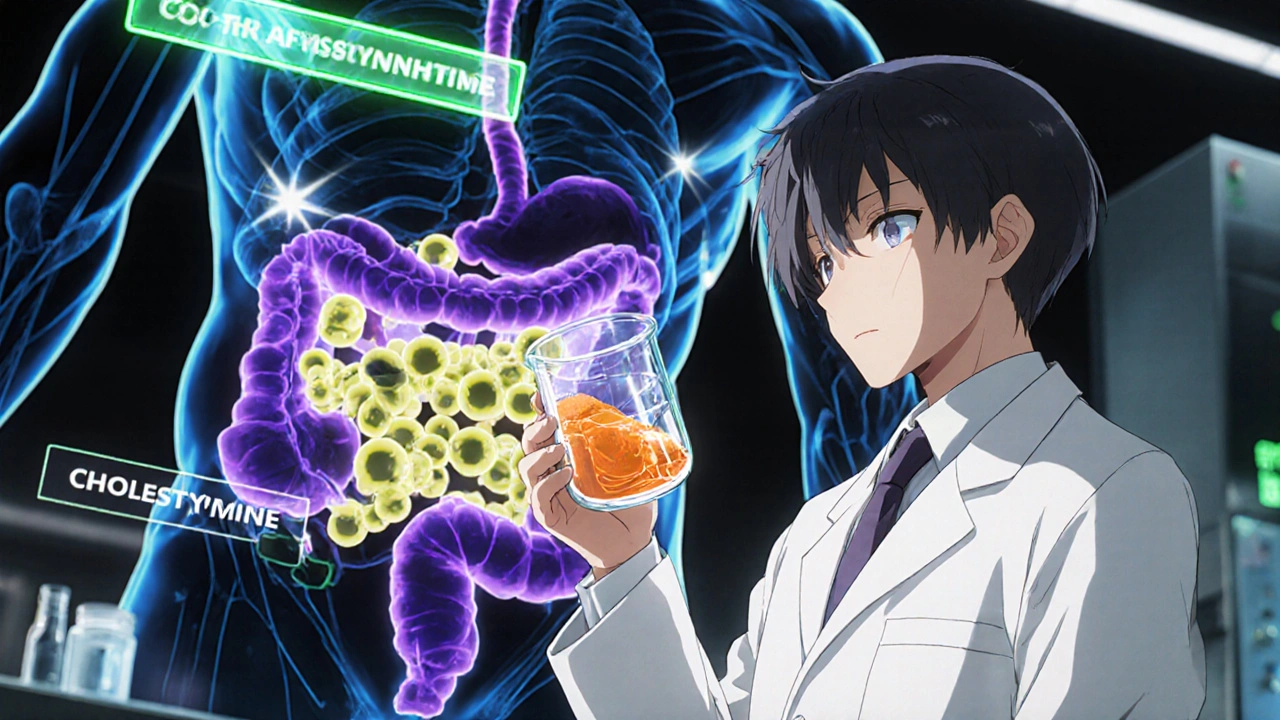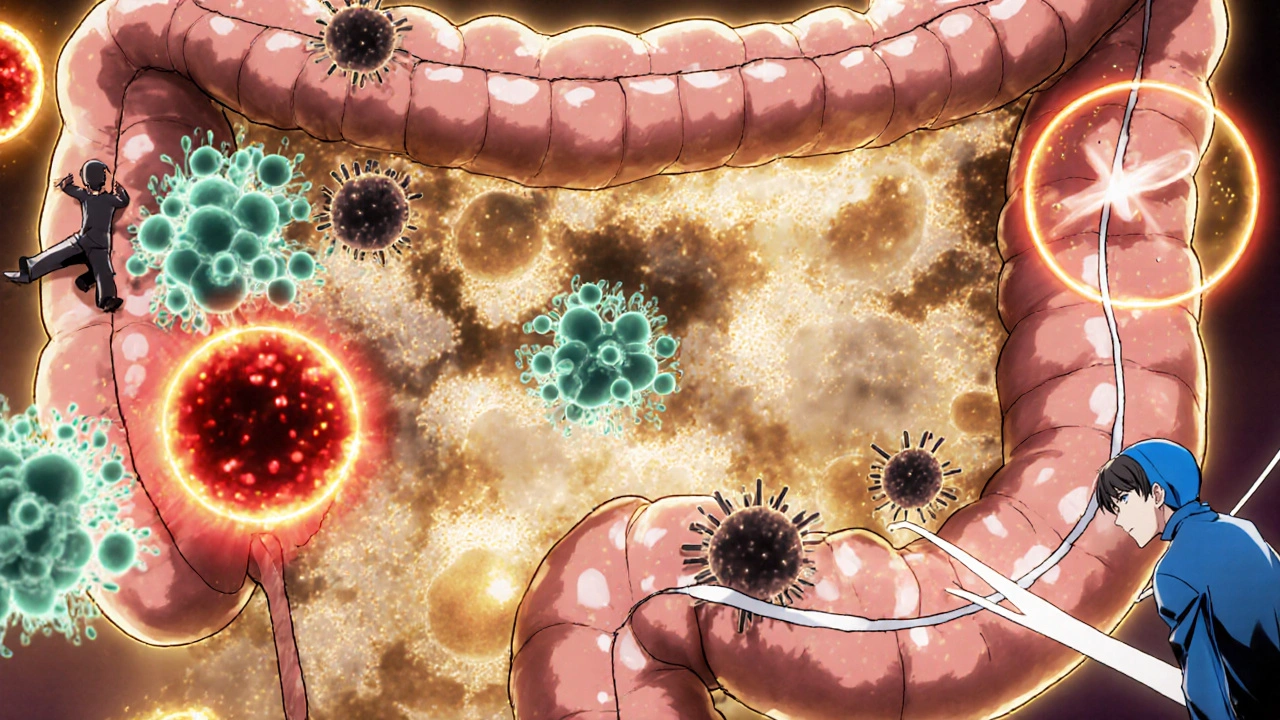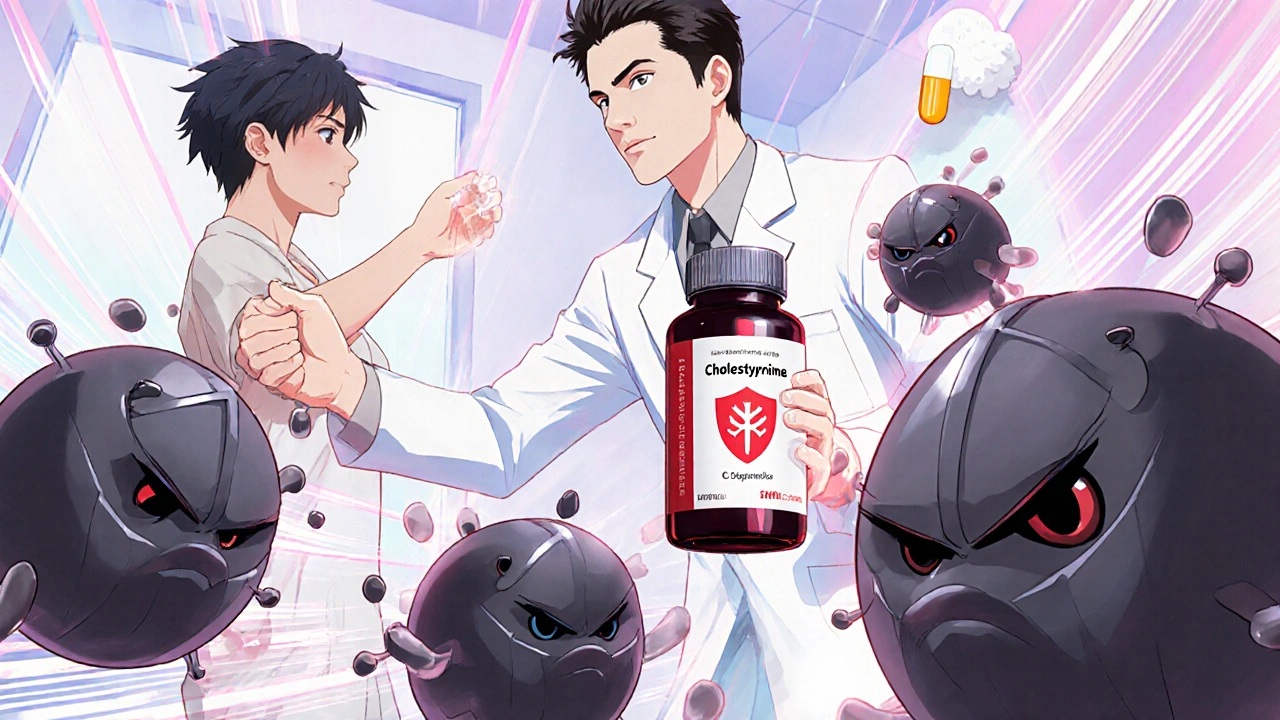Cholestyramine and Immune Health: Does It Boost Your Defenses?

Cholestyramine Effectiveness Checker
Does Cholestyramine Make Sense for Your Condition?
Answer a few simple questions to determine if clinical evidence supports using cholestyramine for your specific situation. This tool is for informational purposes only and should not replace medical advice.
Ever wonder if a cholesterol‑lowering drug could also give your immune system a leg up? cholestyramine has been prescribed for decades to bind bile acids, but a growing body of research hints that it might do more than just trim cholesterol. This article unpacks what cholestyramine is, how it interacts with the gut and the immune system, and whether you should consider it as an immune‑support tool.
Quick Takeaways
- Cholestyramine is a bile‑acid sequestrant that works in the large intestine.
- By removing bile acids, it can alter the gut microbiome and lower inflammation.
- Clinical studies show modest effects on certain immune‑related conditions, such as Clostridioides difficile infection and some types of diarrhea.
- Side effects (bloating, constipation, nutrient absorption issues) limit routine use as an immune booster.
- Other sequestrants (colestipol, colesevelam) share similar mechanisms but differ in taste, dosing, and cholesterol‑lowering potency.
What Is Cholestyramine?
Cholestyramine is a high‑molecular‑weight, anionic resin that binds negatively charged bile acids in the gastrointestinal tract. The binding creates an insoluble complex that is excreted in stool, forcing the liver to synthesize new bile acids from cholesterol. This cycle lowers serum LDL‑cholesterol and is why doctors have used cholestyramine for hypercholesterolemia since the 1960s.
Because it stays in the gut and isn’t absorbed, cholestyramine has a relatively low systemic toxicity profile, but it can interfere with the absorption of fat‑soluble vitamins (A, D, E, K) and some medications.
How Does It Work? The Bile‑Acid Connection
Bile acids are amphipathic molecules synthesized from cholesterol in the liver. They emulsify dietary fats, aid in fat‑soluble vitamin absorption, and act as signaling molecules via receptors such as FXR (farnesoid X receptor) and TGR5.
When cholestyramine removes bile acids from the intestinal lumen, it interrupts these signaling pathways. Reduced FXR activation can lower intestinal inflammation, while altered TGR5 signaling influences energy expenditure and immune cell trafficking.
The Gut Microbiome Bridge
Gut microbiome composition is highly sensitive to bile‑acid concentrations. Certain bacterial families, like Bacteroidetes, thrive on bile salts, whereas others, such as Clostridia, are suppressed.
By depleting bile acids, cholestyramine creates a niche for bile‑acid‑sensitive microbes to flourish. Studies in mouse models have shown that this shift can increase the production of short‑chain fatty acids (SCFAs) like butyrate, which are known to reinforce the intestinal barrier and modulate immune responses.

Immune System Links: Cytokines, T Cells, and IgA
Cytokines are signaling proteins that direct immune cell behavior. In rodent experiments, cholestyramine‑treated groups displayed lower levels of pro‑inflammatory cytokines (TNF‑α, IL‑6) after a gut‑derived endotoxin challenge.
Similarly, T cells isolated from the mesenteric lymph nodes of cholestyramine‑fed mice showed a higher proportion of regulatory T cells (Tregs), which help prevent excessive immune activation.
On the mucosal front, IgA (immunoglobulin A) secretion was modestly increased, enhancing the gut’s first line of defense against pathogens.
Evidence From Human Studies
Human data are more limited but still informative:
- Clostridioides difficile infection (CDI): A 2022 randomized trial gave cholestyramine to patients after standard antibiotic treatment. Those receiving the resin had a 30% lower recurrence rate, likely due to reduced bile‑acid‑driven spore germination.
- Diarrhea in patients on bile‑acid sequestrants: A 2021 meta‑analysis of 12 studies found that cholestyramine improved stool consistency in patients with bile‑acid malabsorption, indirectly reducing gut‑derived inflammation.
- Inflammatory bowel disease (IBD): Small pilot studies reported symptom relief in ulcerative colitis patients, but the evidence is not strong enough for guideline recommendations.
Overall, the human literature suggests cholestyramine can modulate gut‑related immune processes, but the effects are condition‑specific and generally modest.
Practical Considerations: Dosage, Side Effects, and Interactions
Typical adult dosing for cholesterol control is 4 g to 16 g per day, taken in 1‑4 divided doses mixed with water or juice. For gut‑related applications, lower doses (2 g to 4 g) are often used.
Common side effects include:
- Flatulence and bloating (due to fermentation of the resin)
- Constipation or, less often, diarrhea
- Reduced absorption of fat‑soluble vitamins; supplementation is advisable.
Drug interactions are important: cholestyramine can bind to digoxin, warfarin, levothyroxine, and some antibiotics, reducing their effectiveness. Always separate dosing times by at least 1‑2 hours.

How Does It Compare to Other Bile‑Acid Sequestrants?
| Attribute | Cholestyramine | Colestipol | Colesevelam |
|---|---|---|---|
| Formulation | Powder mixed with liquid | Powder mixed with liquid | Chewable tablet |
| Typical adult dose (cholesterol) | 4-16 g/day | 5-15 g/day | 3.75 g (1.25 tablet) twice daily |
| Effect on LDL‑C | ≈15-20% reduction | ≈12-18% reduction | ≈15% reduction |
| Impact on gut microbiome | Strong bile‑acid depletion → notable microbiome shift | Similar but milder | Least impact (tablet form) |
| Common side effects | Gas, constipation, vitamin malabsorption | Similar to cholestyramine | Less GI upset, mild dyspepsia |
All three drugs share the core mechanism of binding bile acids, but cholestyramine’s powder form gives it a more pronounced effect on the intestinal environment, which is why it’s the most studied for immune‑related outcomes.
When Might Cholestyramine Offer an Immune Edge?
Based on the evidence, the resin appears most useful in narrow scenarios:
- Preventing CDI recurrence: By reducing bile‑acid concentrations that fuel spore germination, cholestyramine can lower the odds of a second infection.
- Bile‑acid malabsorption‑related diarrhea: Improving stool form reduces gut inflammation, indirectly supporting mucosal immunity.
- Adjunct in certain IBD flares: Small studies suggest symptom relief, but it should never replace standard anti‑inflammatory therapy.
For healthy individuals seeking a generic “immune boost,” the benefits are unproven and the risks (nutrient deficiencies, drug interactions) outweigh any marginal advantage.
Bottom Line: Is Cholestyramine an Immune Booster?
Cholestyramine does influence the gut‑immune axis by reshaping the microbiome, lowering pro‑inflammatory signals, and enhancing mucosal IgA. However, its effects are modest, condition‑specific, and come with a side‑effect profile that limits routine use purely for immune enhancement.
If you have a cholesterol issue, cholestyramine remains a solid, low‑cost option. If you’re dealing with a gut‑related immune problem-especially recurrent C. difficile-talk to your doctor about a short course of the resin. For general wellness, focus on proven strategies: balanced diet, adequate sleep, regular exercise, and, if needed, targeted supplements.
Frequently Asked Questions
Can I take cholestyramine to prevent colds?
Current research does not support using cholestyramine as a preventive measure for viral respiratory infections. Its immune effects are limited to the gut environment and do not translate into systemic protection against colds.
How long should I stay on cholestyramine for immune‑related purposes?
Therapeutic courses in clinical trials range from 2 weeks to 3 months, depending on the indication. Long‑term use should be monitored for vitamin deficiencies and altered lipid profiles.
Will cholestyramine affect my gut bacteria negatively?
It reshapes the microbiome, often increasing bile‑acid‑sensitive species. In most cases this shift is neutral or beneficial, but individual responses vary, so probiotic support may be useful.
Can I take cholestyramine with my thyroid medication?
Levothyroxine can bind to the resin, reducing absorption. Separate the doses by at least 2 hours to avoid interference.
Is cholestyramine safe for children?
Pediatric use is limited to specific lipid disorders and under close medical supervision. Immune‑related applications have not been studied in children.






Comments
Dante Russello
October 23, 2025 AT 18:05Cholestyramine's role in gut‑immune cross‑talk is fascinating; by binding bile acids it forces the liver to pull more cholesterol from the bloodstream, which in turn reshapes the microbial landscape, and that shift can dampen pro‑inflammatory signals. The resin stays locked in the colon, so systemic toxicity is low, but you have to watch fat‑soluble vitamin levels, especially A, D, E, and K. In practice, a low‑dose course (2–4 g/day) can improve stool form in bile‑acid malabsorption, and some trials even show a drop in C. difficile recurrence. Keep in mind the side‑effects-bloating, constipation, and possible drug interactions-so timing of other meds matters. Overall, think of it as a gut‑focused adjunct rather than a magic immune booster.
James Gray
October 23, 2025 AT 19:20Hey Dante! i totally get the vibe-using cholestyramine as a gut‑helper can actually be pretty rad, especially when you pair it with a probiotic and some vitamin D. just remember to space out your meds by a couple of hours so the resin doesnt steal them. This shoudl help keep that “immune edge” without the big side‑effects. keep it up!
Scott Ring
November 1, 2025 AT 13:26I appreciate the detailed breakdown; one thing to add is the FXR‑TGR5 signaling cascade, which can influence not just inflammation but also bile‑acid synthesis itself. When you blunt FXR activation with cholestyramine, you may see a modest rise in hepatic bile‑acid production, creating a feedback loop that the microbiome picks up on. In my experience, patients who also take a low‑dose prebiotic notice a smoother transition and fewer gas complaints. So, think of cholestyramine as part of a broader gut‑support regimen, not a standalone cure‑all.
Shubhi Sahni
November 1, 2025 AT 14:50Great points, Scott! Indeed, the feedback loop you mention often manifests as a temporary increase in stool frequency, which typically settles after a week or two. Additionally, because the resin can bind fat‑soluble vitamins, I always advise a daily multivitamin with extra A, D, E, K - especially for patients on long‑term therapy. Monitoring serum levels can prevent deficiencies before they become clinically apparent.
Danielle St. Marie
November 13, 2025 AT 03:13Honestly, taking a cholesterol binder to “boost immunity” sounds like a marketing gimmick 😒.
Celeste Flynn
December 6, 2025 AT 06:46Cholestyramine has been around since the 1960s and its primary function is to trap bile acids in the gut. The trapped acids are excreted, forcing the liver to use cholesterol to make new bile. This mechanism lowers LDL levels reliably in many patients. What many people overlook is how this bile‑acid depletion reshapes the gut ecosystem. Certain bacteria that thrive on bile salts decline while others that prefer a low‑bile environment expand. The expansion often includes species that produce short‑chain fatty acids such as butyrate. Butyrate is known to strengthen the intestinal barrier and modulate immune cells locally. In animal models reduced inflammatory cytokines like TNF‑α and IL‑6 have been observed after cholestyramine treatment. Human studies are more modest but they do show lower recurrence rates of C. difficile when the resin is used after antibiotics. A meta‑analysis of bile‑acid malabsorption trials also reported improvements in stool consistency. For inflammatory bowel disease the evidence is still preliminary and should not replace standard therapies. One practical concern is the binding of fat‑soluble vitamins which can lead to deficiencies if not supplemented. Another issue is drug interactions; levothyroxine, warfarin and some antibiotics can be absorbed less efficiently. Timing doses at least two hours apart usually mitigates this problem. For most healthy individuals the marginal immune benefits do not outweigh the inconvenience of mixing a powder with juice. If you have a specific gut‑related issue like recurrent C. difficile or bile‑acid diarrhea then a short course under medical supervision can be worthwhile. Otherwise focus on proven immune strategies such as a diverse diet, regular exercise and adequate sleep.
prithi mallick
December 6, 2025 AT 08:10i totally agree w/ Celeste-this resin is def not a cure‑all but it can help in specific gut issues. just watch out for vits and drug timing.